|
Solar System Transformation
It's Not just Global Warming on Earth!
The significant — nay, unprecedented — weather changes, currently alarming millions here on Earth, are ultimately part of an overall, mysterious transformation that is affecting the Sun, a number of other planets and many of their satellites … all across the solar system.
Richard C. Hoagland & David Wilcock, 2004
Major transformation of our solar system is well underway. On Earth this has been called “global warming” and has become a major political issue. Consequently, there seems to be a major campaign underway to convince the general public that humans are to blame, when in reality, solar, cosmic and galactic energy is driving evolutionary change. The Joyfire perspective is to point out the research that documents that ALL the planets in our solar system are changing, often in a matter of decades and sometimes in only a few years. The unprecedented signs of atmospheric changes, new major storms and polar vortexes on the planets in our solar system is leaving scientists wondering about where the energy is coming from, as energy from the Sun is not considered variable enough to provoke major outbursts of activity on the various planets in the solar system. So, regardless of the strange inconsistent activity of the Sun that includes the recent period of high activity, see link 1 & link 2 that is itself unexplained, the enigmas for mainstream science just continue to mount. The following information is only a short summary of the wealth of information now available for scrutiny and consideration.
Global Warming on Mars & Pluto?
|
In April 2007, it was widely reported that global warming could be heating Mars four times faster than Earth due to a mutually reinforcing interplay of wind-swept dust and changes in reflected heat from the Sun. Scientists had discovered that for three Mars summers in a row, deposits of frozen carbon dioxide near Mars' south pole have shrunk from the previous year's size, suggesting major global warming is in progress. If you want to check out the facts you can view the satellite data here.
It may appear to some that scientists have made this assertion after too short a period of observation, and are confusing weather with climate on Mars. Well, other substantial and rapid changes over the last decade or so has caused scientists to concede that Mars is emerging from an ice age.
Moreover, between the mid-1970s and 1995, Mars developed significant new cloud cover, had an overall reduction in atmospheric dust content, and revealed a “surprise abundance” of ozone in its atmosphere. The real clincher is that NASA's Mars Global Surveyor unmanned spacecraft was damaged in 1997 by an unexpected 200% local increase in the density of Mars' atmosphere. You can't really argue about that! So, even though some would suggest that the melting of the ice caps should not be considered to be a global phenomenon, the atmospheric changes are planet-wide.
Even more surprising is the suggestion by astronomers of global warming on Pluto, the coldest and most distant planet in our solar system. In 1989 it reached its closest point to the sun, causing bits of its icy surface to evaporate. Yet, since this time, scientists report a three-fold increase in the planet's atmospheric pressure in just 14 years, even as Pluto moves farther from the Sun on its long, odd-shaped orbit. Our scientists openly admit they don't understand why, see Pluto is undergoing global warming, researchers find.
In 2011, scientists reported that pluto's atmosphere had expanded “dramatically” since 2000, and for the first time researchers have detected carbon monoxide. Data collected around the turn of the century suggested that Pluto's cold, diffuse atmosphere extended no more than 135 kilometers above the planet's surface, but based on data collected between August 2009 and May 2010, the atmosphere now reaches heights of more than 3000 kilometers — a distance almost one-quarter of the way to Charon, Pluto's largest moon. That is quite a change. Researchers state:
The Hubble pictures underscore that Pluto is not simply a ball of ice and rock but a dynamic world that undergoes dramatic atmospheric changes.
Hubble Catches Pluto Changing With The Years, Space Daily, 5th February 2010
But then, in February 2011, NASA scientists reported they were stunned by detailed images Pluto's surface revealed it has dramatically changed colour over just a two-year period, it is now 20 per cent more red than it used to be.
Marc Buie, of the Southwest Research Institute, said: “It's a little bit of a surprise to see these changes happening so big and so fast. This is unprecedented.”
Source: How the face of Pluto changed in just two years (do you think they can blame it on global warming?)
Well, just when you think there simple can't be any more incredible changes, astronomers start to mutter that Pluto could be a comet because it is now sporting a tail. Well, planets are all variations generally lose their atmospheres to space. In the case of Pluto, the top layer of atmosphere — where the carbon monoxide resides — is being blown back by the solar wind into to form the tail. The point of interest is that this is a consequence of pluto's newly expanding atmosphere, see More Surprises From Pluto.
|
|
|
Fluctuating changes and climate shift on Jupiter
|
This image of Jupiter, taken by the Hubble Space Telescope, shows the three White Ovals to the southwest of the planet's Great Red Spot. Two of the White Ovals disappeared between 1997 and 2000, and the last spot has become a “Red Spot Jr.,”. This has been interpreted as a sign that the planet is about to undergo a major climate shift within the next decade, according to a UC Berkeley expert in fluid dynamics. Who states:
“I predict that due to the loss of these atmospheric whirlpools, the average temperature on Jupiter will change by as much as 10 degrees Celsius, getting warmer near the equator and cooler at the poles”.
Yet, there are other light spot dynamics which scientists admit are just plain mysterious. After one century of observations, a new Dark Spot near the north pole, now rivals the Great Red Spot, which in recent decades it's more like the Pink Salmon Spot!
In May 2010, it was reported that Jupiter had lost one of its belts. The South Equatorial Belt (SEB) had faded away leaving just the north belt (NEB) viewable in small telescopes, see Jupiter loses one of its belts. In October 2012, a NASA scientist summed this up as follows.
“The changes we're seeing in Jupiter are global in scale,” Orton said. “We've seen some of these before, but never with modern instrumentation to clue us in on what's going on. Other changes haven't been seen in decades, and some regions have never been in the state they're appearing in now. At the same time, we've never seen so many things striking Jupiter. Right now, we're trying to figure out why this is all happening.”
NASA: Signs of massive climate shift on Jupiter as giant planet is under bombardment
NASA JPL News, 17th October 2012
While Jupiter's own atmosphere has been dramatical changing, a number of objects have plunged into Jupiter's atmosphere, creating fireballs visible to professional and amateur astronomers alike. Three of objects – probably less than 45 feet (15 meters) in diameter – have been observed since 2010. The latest of these hit Jupiter on September 10, 2012, although infrared investigations suggest these events did not cause lasting changes in the atmosphere, unlike those in 1994 when “comet” Shoemaker-Levy 9 hit or 2009 when a small comet or asteroid plunged into the atmosphere of Jupiter leaving a large “bruise“. Based on all the available information, it is impossible to not come to the conclusion that a new flow of intergalactic tide of energy is transforming all the planets in our solar system.
|
|
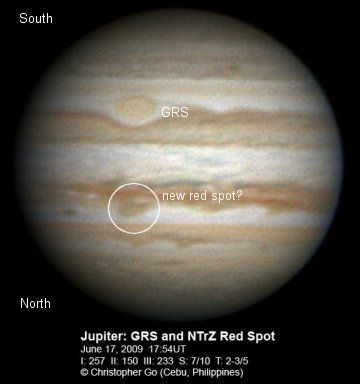 Jupiter changes it's spots Jupiter changes it's spots
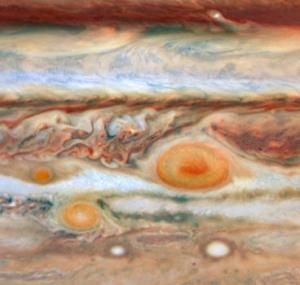 Red Spot Junior Red Spot Junior A new red spot forming in Jupiter's northern hemisphere is nearly as large as the Great Red Spot itself. Click image for more information and images.
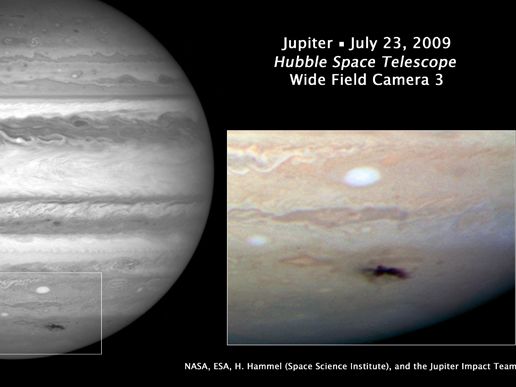 A black mark in Jupiters South Polar Region (SPR) is most certainly the result of a large impact — either an asteroid or comet — similar to the Shoemaker-Ley impacts in 1994. Click image to see enlarged.
|
Saturn stuns the experts!
|
There is a wide selection of changes that have been taking place on Saturn, some are briefly listed here as follows:
-
Unpredicted slow down of equatorial winds that subsided from a rapid 1700 km/hr during the Voyager spacecraft flybys in 1980-81 to a modest 990 km/hr from 1996 to 2002. Scientists are not sure why.
Spokes were first observed lying across Saturn's rings during the Voyager flybys in 1980-1981. By 2004, the Cassini spacecraft failed to detect these spokes because they had disappeared, see Mystery of Saturn's vanishing 'spokes' illuminated . Curiously, the spokes were found in Saturn's B ring Dare in September 2005 see 6.
Between 1980 and 1996, the speed of rotation for Saturn's clouds at the equator reduced dramatically by 58.2 percent.
-
Though Saturn has had three fly-bys — by Pioneer II (in 1979) and Voyagers 1 and 2 (in 1980 and 1981, respectively) — it wasn't until 1995 that a bright aurora was photographed around Saturn's poles by the Hubble Space Telescope. This aurora covers an enormous area across the pole and is capable of rapid changes in its brightness in short periods of time. This was a totally unpredicted discovery, see Mysterious Light Show Seen at Saturn.
-
In April 2011, it was reported that much stronger electrical activity was being seen between Saturn and its moon Enceladus as a current flowing from Saturn's north polar region to south polar region via Enceladus. (This is similar to the massive Birkeland current that connects Jupiter to its moon Io via the poles.) The surprise was that in only about 12 years, the link had become 1000% denser than expected between 1981 and 1993, see Cassini Sees Saturn Electric Link with Enceladus.
-
Highly anomalous emissions of x-rays from Saturn's equatorial region were detected for the first time in 2004, by NASA's Chandra X-Ray Observatory, operating in Earth orbit.
Finally, the phenomena of a “upper atmosphere, standing wave pattern“, hexagonal shaped vortexes of multi-tiered linear cloud spinning like a hurricane in Saturn's north pole. In high-resolution pictures and video, scientists ses the hurricane's eye is about 1,250 miles (2,000 kilometers) wide, 20 times larger than the average hurricane eye on Earth. Thin, bright clouds at the outer edge of the hurricane are traveling 330 mph(150 meters per second). Saturn's north pole was last imaged under sunlight by NASA's Voyager 2 in 1981 but the observation geometry did not allow for detailed views of the poles. Consequently, it is not known how long this newly discovered north-polar hurricane has been active. Whatever, this provides clear evidence that Saturn's atmosphere at the poles reflects a vibrational influence that some believe is hyperdimensional.
|
|
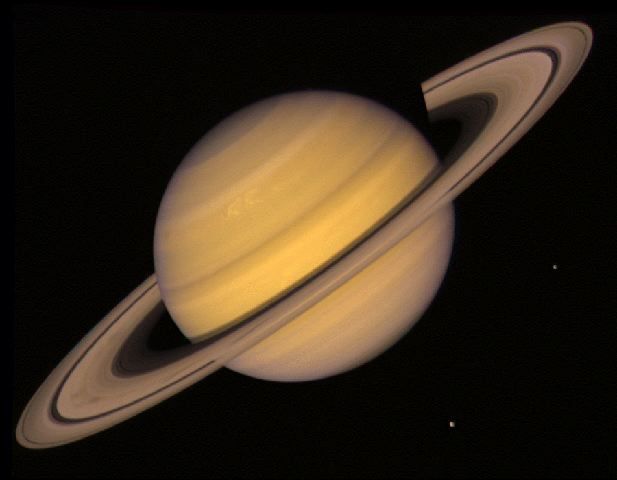
The planet Saturn
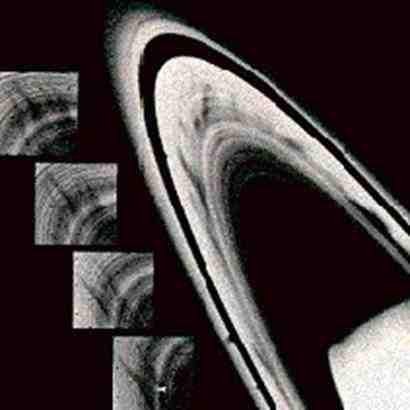
The Spokes of Saturn Composite Image of “Spoke” Formations Observed by Voyager in 1980-81. Click image for the background story. Credit: NASA
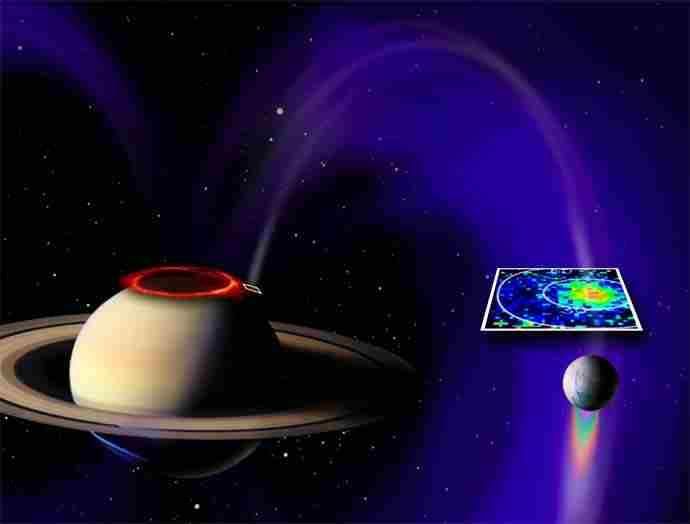 Saturn and its moon Enceladus are linked electrically. Click image for NASA video.
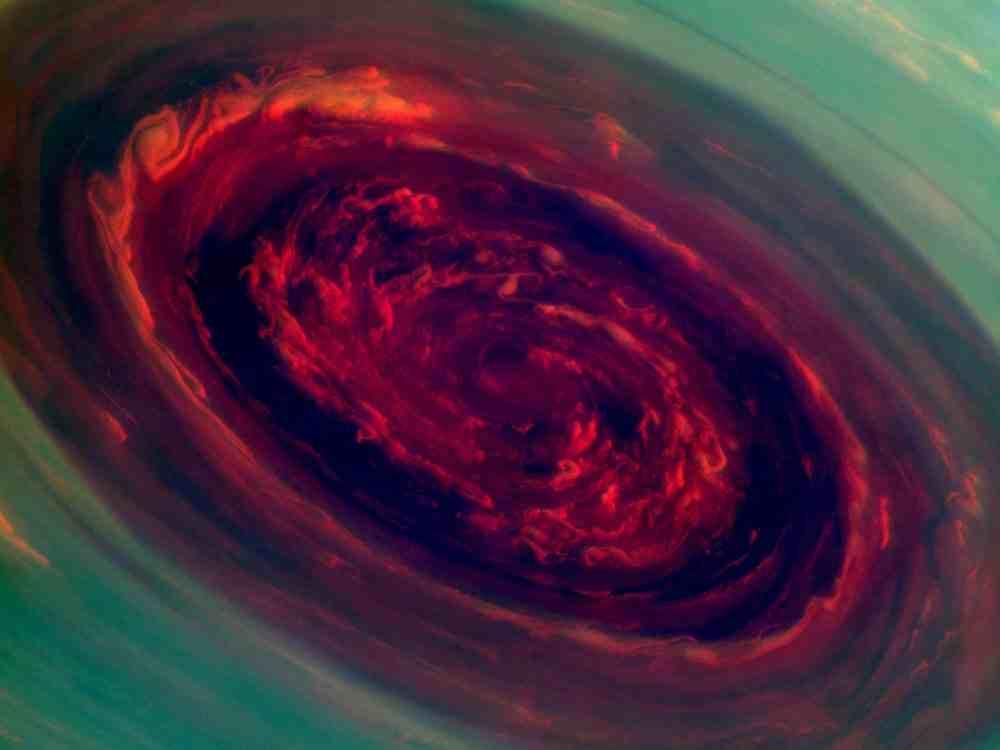 The Saturn Rose
This image was taken with the Cassini spacecraft narrow-angle camera on Nov. 27, 2012. Click image for NASA slideshow.
|
“As they say on Neptune, global warming has become an inconvenient truth.”
|
Neptune is the planet farthest from the Sun (Pluto is now considered only a dwarf planet), with clear cut evidence of “global warming”, what's more Neptune's largest moon, Triton, seems to have heated up significantly since the Voyager space probe visited it in 1989 .
Neptune has 17 times the mass of the Earth, orbits the Sun at a distance 30 times the distance from the Earth to the Sun and Neptune revolves around the Sun once every 164.8 Earth years. Hence the “surprise”, when an article appeared in a recent issue of Geophysical Research Letters showing a stunning relationship between the solar output, Neptune’s brightness, and the temperature of the Earth. Researchers conclude:
“In summary, if Neptune’s atmosphere is indeed responding to some variation in solar activity in a manner similar to that of the Earth albeit with a temporal lag” then “Neptune may provide an independent (and extraterrestrial) locale for studies of solar effects on planetary atmospheres.”
Source: World Climate Report.
Well, things have now moved on and in September 2011, Space.com reported New Photos Show Blazingly Bright Uranus & Neptune in Infrared, the previously dark dank Neptune was now “aflame” in the infrared. To the naked eye, Neptune would appear blue and Uranus bluish-green. But in infrared light these planets blaze like neon lights in the dark night of deep space. The bright streaks on Neptune, represent high-altitude clouds that are reflecting a lot of light. Neptune is now a stormy place, hosting some of the most violent maelstroms in the solar system.
|
|
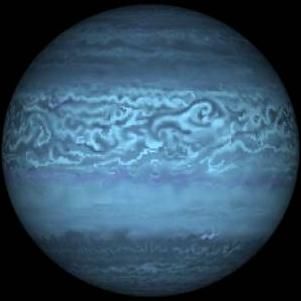 The Planet Neptune The Planet Neptune Neptune's atmosphere is primarily composed of hydrogen and helium, with traces of methane that account for the planet’s distinctive blue appearance.
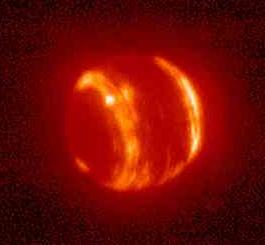 Neptune “aflame” in the infrared Neptune “aflame” in the infrared CREDIT: Mike Brown/Caltech
|
Really big, big changes on Uranus
|
In 1986, when when Voyager space probe flew by, Uranus “appeared as featureless as a cue ball”. Then in 1996, bright clouds began appearing and by 1998, many more clouds apppeared that were “almost as large as continents on Earth, such as Europe”. About a year later in 1999, with the changes only continuing to increase, NASA press releases stated that Uranus was being “hit” by “Huge Storms,” making it “a dynamic world with the brightest clouds in the outer solar system.” A a senior research associate at the Lunar and Planetary Laboratory referred to these increasingly bright and active clouds as “really big, big changes” on Uranus compared to what we had been seen with Voyager just 13 years before.
Carbon monoxide (CO) gas was detected in Uranus' atmosphere for the first time in December 2003, and the observing scientists feel that this gas comes from dust flowing throughout the solar system... In 2012, scientists once again described the tempestuous atmosphere on Uranus that was coming into focus using infra-red telescopes. New observations by the Keck Observatory are showing that Uranus actually has an active weather system in distinct bands, much like that of Saturn or Jupiter. Thus, the following was made clear that the driver of these features must be solar energy because they have no other suggestions for another detectable internal energy source. In a Universe Today article, a scientist stated:
“But the Sun is 900 times weaker there than on Earth because it is 30 times further from the Sun, so you don't have the same intensity of solar energy driving the system,” said Sromovsky. “Thus the atmosphere of Uranus must operate as a very efficient machine with very little dissipation. Yet the weather variations we see seem to defy that requirement.” [...]
“Uranus is changing,” he said, “and there is certainly something different going on in the two polar regions.”
[Bold and emphasis added]
Source: Uranus has Bizarre Weather (For a planet once thought to be rather placid), Universe Today, 18th October 2012
It seems that space scientists are very certain change is taking place but they are not sure where the energy is coming from as few wish to consider the source could be hyperdimensional.
|
|
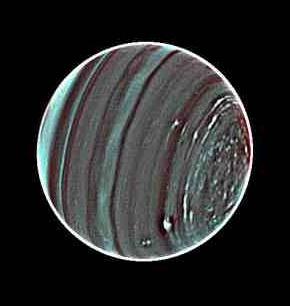 New Infrared images of Uranus New Infrared images of Uranus Click here for 1998 images. Credit: NASA/ESA/L. A. Sromovsky/P. M. Fry/H. B. Hammel/I. de Pater/K. A. Rages

A dramatic new time-lapse movie by the Hubble telescope shows for the first time seasonal changes on the planet. Uranus has had a big makeover. It is now a dynamic world with the brightest clouds in the outer solar system and a fragile ring system that wobbles like an unbalanced wagon wheel. Click image for movie.
Breaking News: Rare Photo: Auroras on Uranus Spotted by Hubble Telescope
|
Venus Puzzles Astronomers
|
Venus has experienced 2500% increase in auroral brightness, and substantive global atmospheric changes in less than 30 years. This includes the amount of sulfur in Venus' atmosphere decreasing “dramatically” between 1978 and 1983 at the same time the new auroral airglow is green in color, which indicates oxygen atoms, but these oxygen emissions are as strong on Venus as they are in Earth's own oxygen-rich aurora suggesting there has been a massive increase in the oxygen content of Venus' atmosphere, see Night Time on Venus.
Yet another sign of a massive overall increase in the energetic behavior of Venus was revealed in 1997. A tail of charged plasma trailing behind Venus was measured to be 60,000 percent longer in 1997 — stretching almost to the Earth — than where it was first discovered in the late 1970s. See, Planet's Tail of the Unexpected New Scientist, 31 May 1997.
In July 2009, it was reported that astronomers were trying to determine the cause of an expanding “white intense spot“ seen in Venus' atmosphere. First seen by an amateur astronomer, the most likely causes initially contemplated were either charged particles from solar interaction with Venus' atmosphere or atmospheric turbulence concentrating bright material in a confined area, see Expanding Spot on Venus Puzzles Astronomers.
In February 2012, it was also reported that the European Space Agency's Venus Express spacecraft revealed that Venus' rotation rate is about 6.5 minutes slower than previous measurements taken 16 years ago by the Magellan spacecraft, see Is Venus' Rotation Slowing Down?. Interestingly, the same had been reported for Saturn using data collected by NASA's Cassini, Pioneer and Voyager spacecraft, which scientists used to revise the ringed planet's rotation period to 10 hours, 32 minutes and 35 seconds – about 15 minutes shorter than an estimate made only the previous year, see Length of Saturn's Day Revised
|
|
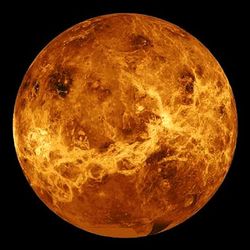
The Fiery Globe of Venus
 The stretched tail of Venus The stretched tail of Venus Click here for the Electric Universe perspective.
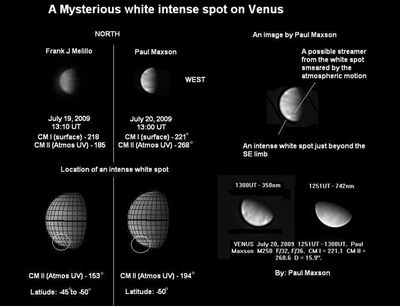 Venus: Intense white spot. Venus: Intense white spot. Click for more info and images. Credit: P. Maxson
|
The Solar System Transition Reports: What's Going On In Our Solar System
|
Two major reports in 1997 and 2004 released into the public domain informed anyone interested that a major transformation of our solar system was taking place.
-
In the Planetophysical State of the Earth and Life Report (1997), (translated into English in 1998,) Russian scientists informed the world that newly observed energetic processes and formations were taking place in our solar system that involved all of the planets, between the planets and their moons, and the planets and the Sun. According to this report, human beings will face “evolutionary challenges” as we are “experiencing a global change in the vital processes of living organisms, or life itself”.
-
Scientists Richard Hoagland & metaphysician David Wilcock produced an extremely comprehensive and fully referenced “Day After Tomorrow” Interplanetary Report (2004), providing evidence from mainstream scientific sources that every single planet in our solar system has changed. Even since this report was published, there have been more changes in the planets. This report explains the cause as a change in the aetheric energy that underpins our reality, where major bleedthroughs of energy help determine the most energetic activity and phenomena seen on all the various planets. Certainly this reports does agree with the notion that we are seeing energy driven evolutionary change.
|
|
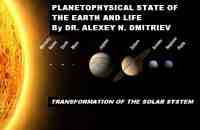 Planetophysical State of the Earth and Life Report (1997) Click the image to check out.
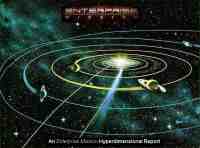
“Day After Tomorrow” Interplanetary Report (2004) Click the image to check out.
|
TourBack
  Next Next
|

